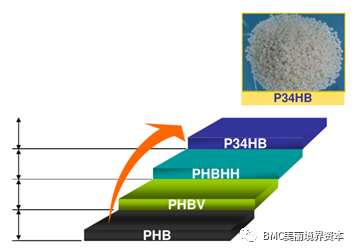Polyhydroxyalkanoate (PHA), an intracellular polyester synthesized by many microorganisms, is a natural polymer biomaterial.
In microbial cells, especially bacterial cells, there is a large number of polymer polyesters – Polyhydroxyalkanoates (PHA). This is a natural polymer biomaterial. It does not specifically refer to a certain polymer, but a general term for a class of polymers with similar structures and different properties.
PHA has roughly experienced four stages of development.
The first generation of PHA, polyhydroxybutyrate (PHB), was mass-produced by Chemie Linz AG in Austria in the 1980s (annual output of 100 tons). As the earliest discovered PHA series material, PHB is also the simplest and most common structure in the PHA family. It has high structural regularity, hard and brittle properties, and its mechanical properties and melting point are similar to polypropylene (PP); but the elongation at break Low rate, high brittleness. Therefore, PHB usually cannot be used as a single material and needs to be modified to achieve applicable performance.
The second generation of PHA, polyhydroxybutyric acid copolyester (PHBV), was commercialized by ICI in the 1980s. PHBV is a PHA copolymer with a molecular weight of over 300,000. PHBV, as an improvement to the first-generation product PHB, has greatly improved its elasticity after adding 3-hydroxyvalerate (3HV) monomer. Because it can be completely decomposed in compost, soil, seawater and other environments, it also has good biocompatibility and high barrier performance to liquids and gases, making PHBV an ideal human tissue engineering material for making medical sutures. wire, bone nails, etc., and can also be used as agricultural mulch, shopping bags, tableware and food packaging materials. At present, the production process of PHBV products has been further developed, and has been applied in golf trays, disposable tableware, films, plates, packaging and other fields.
The third generation of PHA—poly 3-hydroxybutyrate-3-hydroxyhexanoate (PHBHHx), since 1998, Tsinghua University Microbiology Laboratory and Guangdong Jiangmen Biotechnology Development Center have successfully developed hydroxybutyric acid for the first time in the world The industrialized production technology of the copolymer PHBHHx with hydroxycaproic acid, and realizes large-scale production. Compared with PHBV, PHBHHx has lower crystallinity and higher ductility, and its performance is comparable to that of polyethylene (PE) plastics.
The fourth-generation PHA—copolymer of poly-3-hydroxybutyrate and 4-hydroxybutyrate (P3HB4HB or P34HB), has good film-forming properties and physical properties, but poor hydrophilicity. The fourth-generation PHA has shown good application prospects in the field of tissue engineering research, such as scaffold materials in bone tissue engineering to load human bone marrow mesenchymal stem cells, etc
Because PHA has good biocompatibility, biodegradability and thermal processing performance of plastics at the same time. Therefore, it can be used as biomedical materials and biodegradable packaging materials at the same time, which has become the most active research hotspot in the field of biomaterials in recent years. PHA also has many high value-added properties such as nonlinear optics, piezoelectricity, and gas barrier properties.
WorldChamp Enterprises will be ready all the time to supply the ECO items to clients from all over the world, compostable glove, grocery bags, checkout bag, trash bag, cutlery, food service ware, etc.
WorldChamp Enterprises is your best partner to expend the ECO products, the alternatives of the traditional plastics products, to prevent the white pollution, make our ocean and earth cleaner and cleaner.
Post time: Feb-10-2023





